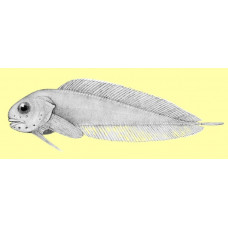Latin name
Paraliparis macrocephalus
Identification
Paraliparis: Greek, para = the side of + Greek, liparis = fat. Macrocephalus: from the Greek words for large and head.
Paraliparis macrocephalus has 56 vertebrae, 49 dorsal, 20 thoracic, 9 caudal. The thoracic radius bones are 3. Head large, 28% of length, 38% of preanal length. Eye 20% of length. Interorbital spaces wide, 61% of snout length. Muzzle very large, twice the diameter of the eye when viewed from the side, well developed subcutaneous gelatinous layer. Nostrils large, tubular. Mouth horizontal, subterminal. Teeth simple. The pores on the head are large. Symphysial pores loosely arranged. The gill opening is on the 2-3rd level anterior to the thoracic ray.
Features of fish fins
Dorsal spines (total): 0; Dorsal soft rays (total): 49; Anal spines: 0; Anal soft rays: 43.
Fish colouring
The body of Paraliparis macrocephalus is pale (pink when alive), greyish towards the abdomen. Peritoneum and gill cavity black, abdomen pale.
Distribution
Southern Ocean: Known from a single specimen collected from the Drygalski Basin in the Ross Sea.
Habitat
A deep-sea marine species, depth range ? - 1191 м.
Size
The maximum length of the male found was 10.4 cm.
Behavior
The behaviour of this species has not yet been studied.
Food and feeding habits
Larvae feed on plankton and adult fish have the most fish in their diet.
Reproduction
Nothing is known about the reproductive biology of the fish species.
Fishing
Paraliparis macrocephalus is of no interest to commercial fisheries.
Relationship with a person
Harmless.
| Classification | |
| Phylum | Chordata |
| Class | Actinopterygii |
| Squad | Perciformes |
| Family | Liparidae |
| Genus | Paraliparis |
| Species | P. macrocephalus |
| Features | |
| Conservation status | Not Evaluated |
| Habitat | Pelagic |
| Life span, years | No information |
| Maximum body weight, kg | No information |
| Maximum length, cm | 10,4 |
| Sailing speed, m/s | No information |
| Threat to people | Edible |
| Way of eating | Predator |

